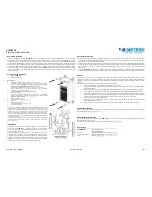
25
Wiring the Optional 0–10 Volt Building
Control Signal
1. A signal from an energy management system
may be connected to the XFiire heater. This signal
should be a 0-10 volt positive DC signal. The energy
management system can be used to control either
the setpoint temperature of a single XFiire or a
cascade of up to 4 heaters, or the firing rate of a
single XFiire heater.
2. To enable this remote control function, set DIP
switch 5 to the UP position on the PIM. DIP switch 5
Toggles between an EMS (UP) signal or a demand
signal from the VERSA (DOWN). DIP switch 2 on the
PIM toggles between a Direct Drive (UP) input and a
Target Temperature (DOWN) setpoint.
3. For a 4-20mA application, refer to the VERSA IC
M
anual (5000.72).
4. Connect an Energy Management system or other
auxiliary control signal to the terminals marked
0-10V (+/-) on the field wiring terminals
. See
Figure
26.
Caution should be used to ensure that the +0-
10V connection does not create a short to ground.
5. Contact closure across the Enable/Disable
connection is required for heater operation in this
configuration.
A
A
CAUTION:
Ensure that the +0-10V connection does
not create a short to ground. +0-10V signal is polarity
sensitivity and must not be reversed. +0-10VDC signal
must not exceed 10VDC.
Wiring the Enable/Disable
Connect the Enable/Disable (terminals 11, 12) wiring to
the field wiring terminals as shown in
Figure 26
and in
place of the factory installed jumper. Alternately, any dry
contact closure (including a remote thermostat) across
these terminals will enable the XFiire heater to run.
A
A
CAUTION:
Ensure neither of the terminals are
shorted to ground.
The 3-position rocker switch (adjacent to the touchscreen
user interface) must be in the "RUN" position for the heater
to operate when enabled.
A
A
CAUTION:
The Enable/Disable signal may be
overridden when the VERSA control is configured for
MODBUS "TEMP" or "RATE". Disable MODBUS prior to
servicing the heater.
Wiring the System Sensor
NOTE:
The System Sensor (S3) is not required for single
unit Primary piping configuration.
The System Sensor (S3) is required for all Primary/
Secondary and all cascade configurations for all selectable
modes unless the unit's firing rate will be controlled by an
external source, such as our TempTracker MOD+ Hybrid
sequencer. Proper placement and method of installation
are critical for proper operation of the system. See
“Applications and Modes”.
1.
When using a System Sensor (S3), connect the
sensor wires to the terminals marked (6, 7) SYSTEM
SENSOR. See
Figure 26.
2. Use a minimum of 18 AWG stranded wire for runs up
to 150' (46 m).
3.
Install the system sensor in a drywell (option B-31)
within 5 feet (1.5 m) downstream of the de-coupler
(primary/secondary system) or last heater (primary).
See
Figure 14
or
Figure 15
as appropriate.
Wiring the Outdoor Sensor
1. If using an Outdoor Sensor, connect the sensor
wires to the terminals (8 & 9) marked OUTDOOR
SENSOR. See
Figure 26.
A
A
CAUTION:
Ensure sensor wiring is not shorted to
ground.
2. Use a minimum 18 AWG stranded wire for runs of up
to 150 feet (46 m).
3. Mount the outdoor sensor on an exterior surface of
the building, preferably on the north or west facing
side in an area that will not be affected by direct
sunlight.
Wiring the Indirect DHW Sensor (Optional)
Connect the indirect tank sensor to the terminals (4
& 5)marked INDIRECT DHW SENSOR.
See
Figure
26.
Caution should be used to ensure neither of these
terminals becomes connected to ground. When using
an indirect DHW Sensor to control tank temperature,
contact closure is required across the indirect override
connections for proper operation.
NOTE:
Alternately, a thermostat contact closure can
be used in lieu of the sensor for indirect operation.
Connect the thermostat to the terminals (10 & 12) marked
INDIRECT DHW OVERRIDE.
When the Indirect DHW call for heat is active, the PIM
communicates this to the VERSA. The VERSA calculates
the optimal operation and sends the firing rate and pump
output requests to the PIM so it can activate the Indirect
DHW Pump and Heater Pump as needed. If optional
Indirect DHW Sensor is connected, the PIM will pass this
Summary of Contents for Xfiire 1000B
Page 54: ...54 6 WIRING DIAGRAM For a full size drawing visit www raypak com ...
Page 70: ...70 NOTES ...
Page 71: ...71 NOTES ...
















































